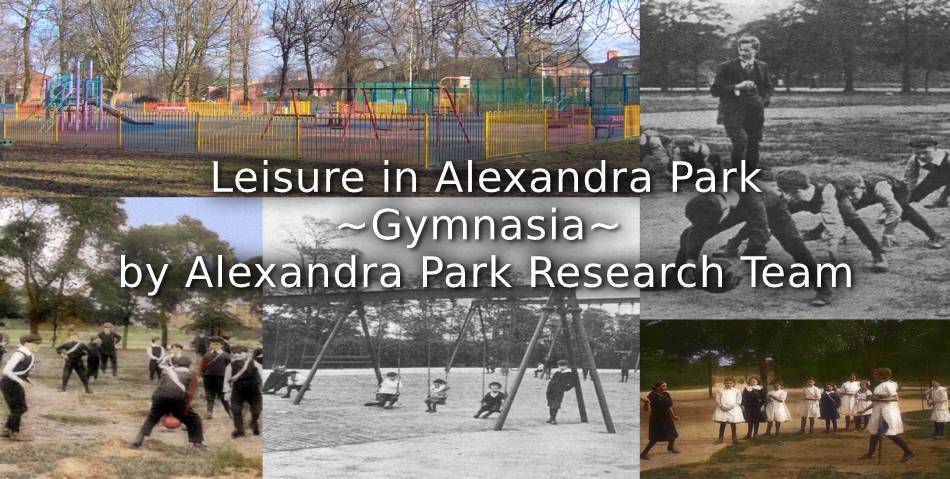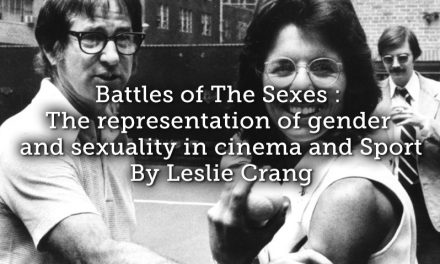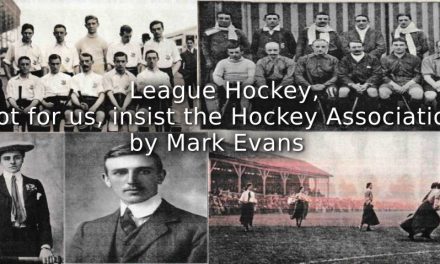Introduction
Perhaps, more than any other aspect of the Alexandra Park, the gymnasia represented the Victorian ideal of rational recreation and took pride of place along with the boardwalk, lake and flower beds when the park opened to visitors in 1870. Situated in what was described as an eight-acre ‘play-ground’, two separate gymnasia, one for boys and one for girls, emphasises both the gendered nature of Victorian spaces and the idea of a healthy, moving body. Steeped in ideas of self-help and moral rectitude, the gymnasia were central to ensuring, what the Mayor of Manchester described as, the ‘manliness of the nation’ and were thought to diminish the problems of war and invasion. While, the gymnasia of Alexandra Park served as a reference point for other cities in the 1880s, in the twentieth century, the transformation of their space into a new lido, suggested both that the popularity of the gymnasia had dwindled and that the moral message attached to them had been supplanted by something new.
The 1870s: An Imperial Playground
With the Franco-Prussian war of July 1870, less than one month old, war was clearly on the minds of the guests at the opening to Alexandra Park on 13th August 1870. Cheers ‘for Prussia’ were exclaimed during the Mayor’s speech and he went on to reiterate the role of park as an essential part of Britain’s Imperial and moral mission. ‘I feel assured’ stated the mayor ‘that the [muscular strength] and muscle which institutions like the park will aid in developing represents that kind of “armed neutrality” which is so well understood and appreciated in Europe, and which has heretofore given to Great Britain the place which she has fairly earned in the service of civilisation.’ The message was clear, Alexandra Park was where the young boys of Manchester would develop the physical and moral character to continue Britain’s imperial expansion and spread of her idea of ‘civilisation’.

Boys training with the ‘Medicine Ball’ 1907
Courtesy of Archive Plus
Hand tinting by Michael Stockton
Throughout the 1870s, the qualities of the gymnasia in forming the future generation were frequently mentioned in the Whitsuntide reports detailing Manchester’s festive leisure opportunities. In 1873, the Manchester Evening News outlined that ‘not a bit too much ground [has been] set apart for those who are to the men and women of the future’ indicating that on Saturdays the gymnastic equipment was particularly busy. As the report proudly exclaimed, ‘no public park is complete without a gymnasium of its own’ reminding ‘men who have lost the elasticity which once belonged to them’ that they could try the bowling green instead. It was a space where fun met purpose as outlined in 1875 by The Manchester Evening News where a report noted that the ‘jovial noise of happy children’ suggested that the gymnasium had ‘all the machinery required by young “muscular Christians” to carry out their antics’. This machinery was ‘in first-rate order’ according to the reports. As the tender for equipment for the gymnasium noted in the minutes of 1870 it was not cheap. In addition to the cost of the flooring the apparatus would costs a further £1190. Such prices were not always a guarantee of quality and the Alexandra Park subcommittee minutes noted that they were ‘surprised and dissatisfied’ by the quality of the hooks and iron supplied in 1871. As the amount of sporting products increased, requests were made for new apparatus and in 1874, a letter was written to the Manchester Courier and Lancashire General Advertiser, which requested a ‘horizontal ladder’ be placed in the park gymnasium. No record of whether the equipment was provided is made in the minutes, however, by the late 1870s, the gymnasia of Alexandra Park were still acclaimed as attractive places for ‘recreation and exercise’ in which those ‘past the stage of infancy, may gratify freely in the taste for athletic exercises which most children possess.’
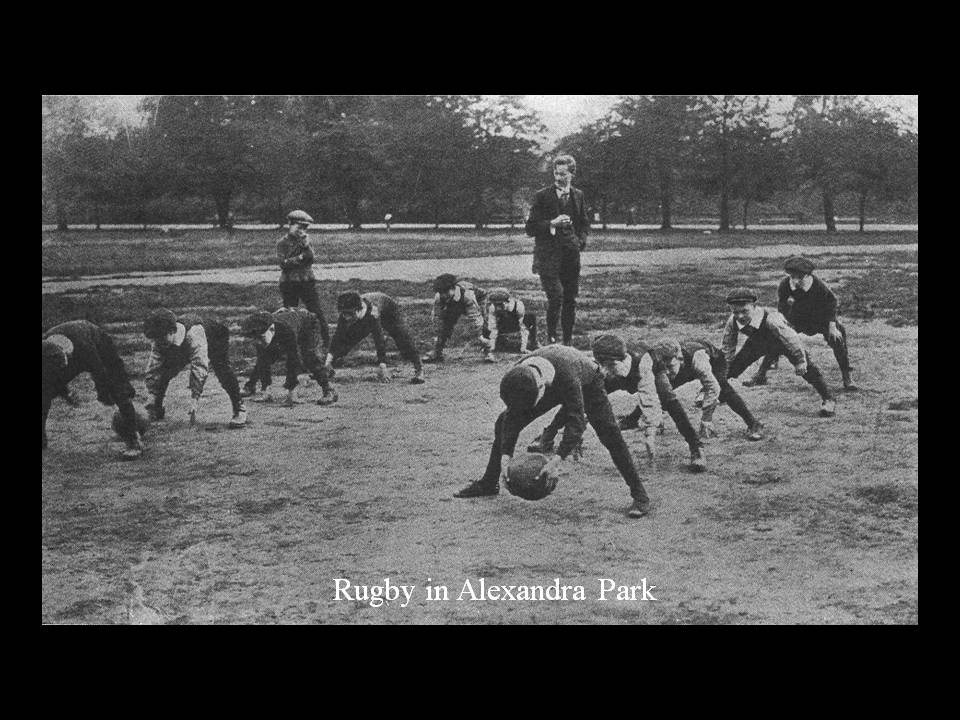
Rugby in Alexandra Park 1907
Courtesy of Archive Plus
The 1880s and 1890s: Recognition and Repair.
Reports in the 1880s continue to outline the popularity of the gymnasia and the utility of the exercises performed there. This was not only noticed by Mancunians and those in the vicinity of the park, but spread further afield and in July 1881, minutes note that a deputation from Birkenhead had arrived to inspect the Alexandra Park gymnasia. As with other park services, the gymnasia often needed repair. In the early 1880s, signs of wear became apparent in both the boys and girls gymnasia and the floors needed replacement, with short-term solutions often favoured over more costly permanent repairs. By Whitsuntide 1884, an overhaul of the gymnasia and swings had been completed and in 1887, wood chipping had been purchased to go under the swings and the parks committee had agreed to a substantial repair of the girls gymnasium floor. The equipment in the separate gymnasia is alluded to in different reports and they suggest that by the mid-1880s, the gymnasia consisted of swings, horizontal bars, and other equipment for strengthening muscles; all of which was thoroughly tested for safety. Despite reports illustrating that boys and girls had separate locations for their games and exercises, there is little information about the differences between the facilities, either in terms of space or equipment. In addition, though Whitsuntide reports outline the popularity of the gymnasia and that the park was the site for local schools to take leisure time, exactly how girls and boys played in the park remains somewhat of a mystery. What we do know is that swings remained a central piece of equipment in the gymnasia in the 1890s and that in the summer of 1894, the old wooden swings were being replaced by new cast iron swings with brickwork beneath; T Shaw of Stockport Road won the tender with a price of £127 beating 3 other local firms to carry out the work.
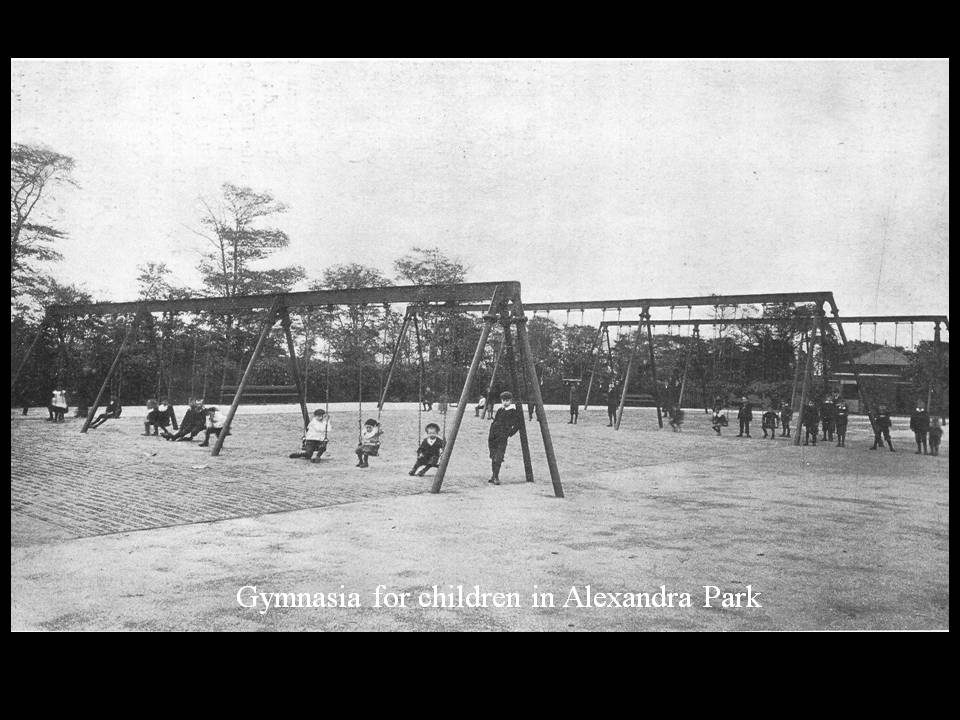
Gymnasia for Children in Alexandra Park
Courtesy of Archive Plus
The twentieth century
By the twentieth century, the importance of the gymnasia seemed to have diminished somewhat and while it was noted as one of the services at the park it was often overlooked in newspaper reports. No doubt the expansion of playgrounds, parks and sporting facilities elsewhere in Manchester took away some of the glamour of the old Alexandra Park gymnasia. By 1930, the original site of the gymnasia in the east of the park was replaced by an open-air lido, with the gymnasia moved towards the north oval. This shift suggests that by the 1930s, the gymnasia, once central to the parks recreational mission had been replaced by newer forms of recreational opportunity and that the old Victorian ideals of ‘rational recreation’ and ‘muscular Christianity’ had given way to seemingly less ideologically constrained leisure spaces.

Girls playing Rounders – 1907
Courtesy of Archive Plus
Hand tinting by Michael Stockton
Pre/post Restoration.
During the latter years of the 20th century and the start of the 21st, the Male Gymnasia, once the Lido was filled in, was turned into a large fenced of ‘MUGA’ (Multi Use Games Area) predominately focused on basketball. Next to it is a fenced off children’s play ground with swings, slide, climbing frame etc, and both are very well used today.
The Female Gymnasia during the 70’s,80’s and 90’s had a wooden structure installed into it, which was known locally as the ‘Pirate Ship’, this was a large climbing frame for older children and teenagers, but by the end of the 90’s this as rotted away and the remains were removed. As part of the ‘Restoration’ the Female Gymnasia site became the tennis Courts, what we see today, and has been written about in a previous article along with the Ping-Pong Table. [See article on Tennis at the Alexandra
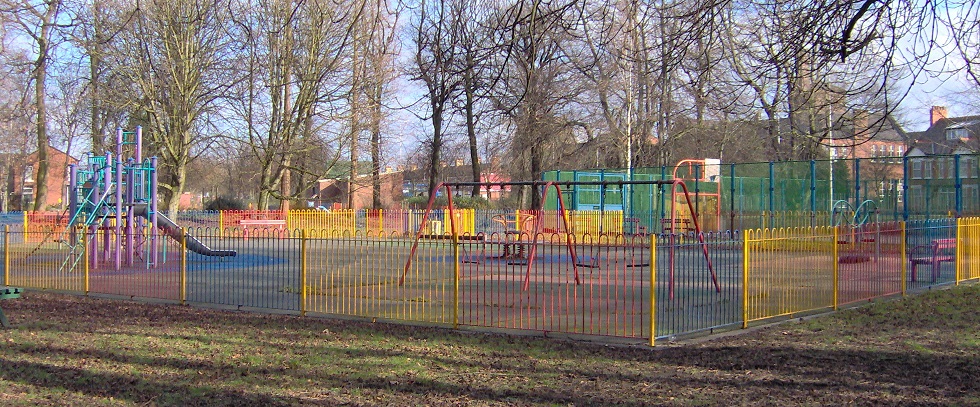
MUGA and Children’s Playground 2008
Image Credit Phil Benson-Hannam
Summary
The gymnasia were the epitome of Victorian relational recreation and their central place in the park’s leisure facilities in 1870 was intrinsically linked to the need to produce fit and healthy citizens to expand Britain’s Imperial aims. While the park and its facilities were designed to provide recreational away from work, the gymnasia are a reminder that this recreation was to be structured and to serve both a physical and moral purpose. That boys and girls were kept separate reinforced the idea of different paths in life for women and men and such public spaces made this distinction clear while outside the home. While recreational play areas were still popular in the twentieth century, the moving of the gymnasia by 1930, suggested that new forms of leisure had emerged in Manchester, with new morals and ideas attached to them.
Article © Alexandra Park Research Team

